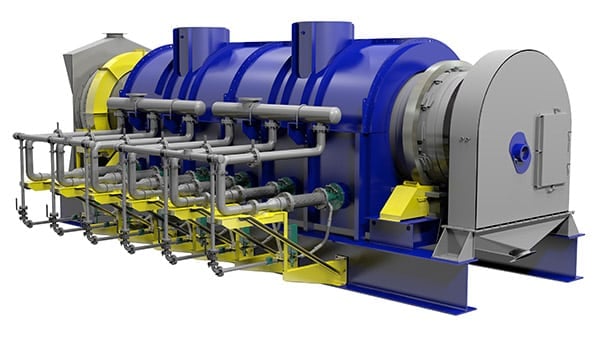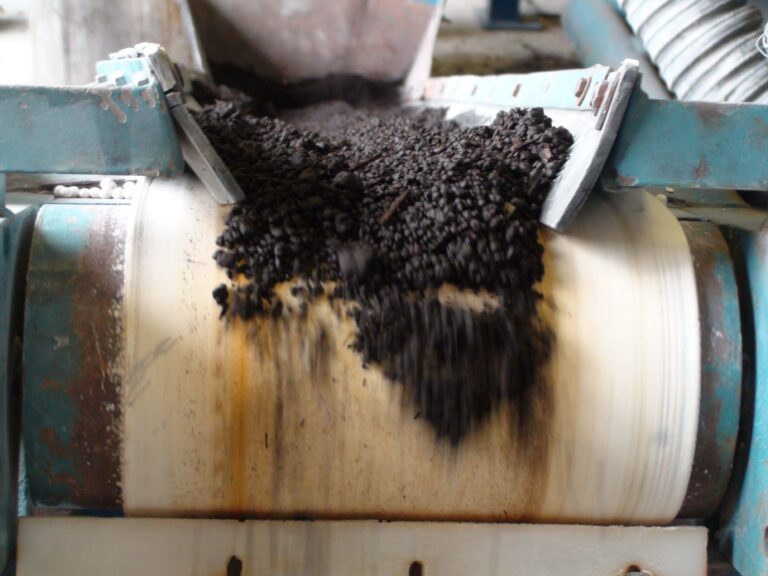Rotary dryers are used across nearly every industry that requires the drying of bulk solids, be it for producing a product for consumer use, serving as an intermediary step in a larger process, or producing an industrial product that will maintain its integrity throughout its lifecycle. To meet these different needs, rotary dryers are designed around the characteristics of the material to be processed.
The engineering behind rotary dryer sizing and design is influenced by a variety of specific material characteristics and how they will combine to respond to drying. One factor that often plays a critical role in the dryer design process is the limitations a material can present.
Material Limitations: Fragility
Direct rotary dryers use direct contact between the material and the products of combustion to dry the material. In order to increase heat transfer efficiency, the interior of the drum is fitted with flights, or material lifters.
These flights pick up material from the bed and drop it through the air stream in a cascading motion as the drum rotates.
While it increases efficiency, this dropping action can be too aggressive for materials of a more fragile nature.
Addressing Fragile Materials Through Dryer Design Modifications
In most cases, undesirable breakdown of a fragile material can be averted by incorporating a “bald” section at the dryer inlet. This flightless portion of the drum gives the material a chance to harden a bit before being gradually introduced to the dropping action, significantly reducing the potential for product degradation.
The durability of the material, in combination with particle size and weight, also influence the maximum air velocity that can be utilized in the dryer without causing entrainment. This air velocity in turn determines the size of fan needed for the rotary dryer and also influences drum diameter.
Material Limitations: Consistency & Makeup
Materials that are sticky or sludge-like can also be problematic for rotary dryers, causing sticking and buildup issues. Some materials, if allowed to continually stick and dry at the inlet, can pose a fire hazard if not carefully managed.
Additionally, materials that are abrasive or corrosive (or both) in nature can also affect the design of a rotary dryer. Materials with challenging characteristics such as these will require special design considerations in order to avoid premature equipment failure or excessive damage to the unit.
Addressing Challenging Materials Through Dryer Design Modifications
There are several ways to address challenging materials such as these through proven design modifications.
Rotary dryers are often fitted with knocking systems for materials that generally have a tendency to stick and build up, such as potash or gypsum. Knocking systems are a simple add-on that serves to dislodge buildup on the interior of the drum by “knocking” the drum externally as it rotates. A wear plate protects the drum shell.
Much like fragile materials, sticky materials can also be addressed through the use of a bald section, and straight lifters. Employing this strategy at the inlet of the dryer allows the sticky feedstock to start the drying process before being introduced to the single and double bend flights. This helps to reduce the opportunity for sticking.
The most effective way to combat abrasion and corrosion is through the proper selection of materials of construction. Choosing materials that are more resistant to abrasion or corrosion from which to construct the shell and any internals is essential. With corrosion in particular, understanding the chemical nature of the material and how it could interact with the materials of construction is essential to the equipment’s longevity.
As corrosion is more likely to occur in cracks and crevices, design modifications that will reduce buildup can also be helpful in this effort.
In abrasive applications lifters can be bolted to the interior of the drum shell instead of welded for ease of replacement in case they wear out over time.
Material End Use Limitations
Rotary dryer design can also be influenced by the intended end use of a product. This is particularly true of consumer products that will require absolute sterility, or materials that must be sterilized through heat.
Similarly, some materials may be combustible under certain settings, such as in the presence of oxygen. In cases such as these, the processing environment must be tightly controlled.
Addressing Controlled Atmosphere Requirements Through Dryer Design Modifications
Rotary dryers that require a tightly controlled atmosphere are best served by the indirect configuration. Indirect dryers avoid contact between the material and the products of combustion by heating the dryer shell from the outside via an enclosed heat shroud, or furnace. The material is heated through contact with the shell (for this reason, flights are not necessary in an indirect configuration).

3D Model of a FEECO Indirect Dryer
The need for sterility can also dictate what type of material the shell of the rotary dryer will be made of. Some materials, for example, cannot be allowed to cake together. In this case, the inside of the rotary dryer would need to be completely polished smooth, with absolutely no imperfections on which the material could catch and pile up.
Conclusion
Material limitations can have a number of ramifications on the design of a rotary dryer. Such limitations may require different materials of construction, an indirect configuration over a direct configuration (or vice versa), a maximum allotted amount of air flow, or other adaptation. While in some cases the required changes may be readily apparent, in others, testing will provide this critical information.
FEECO is a world leader in proficiently drying bulk solids through engineered designs and custom dryer systems. We also offer a unique testing facility for conducting drying tests, as well as a comprehensive line of parts and service support for dryers. For more information, contact us today!



